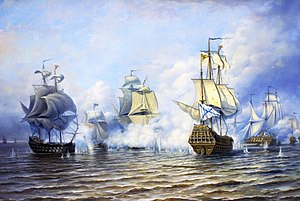| This article includes a list of general references, but it lacks sufficient corresponding inline citations. Please help to improve this article by introducing more precise citations. (January 2022) (Learn how and when to remove this message) |
| Battle of Osel Island | |||||||
|---|---|---|---|---|---|---|---|
| Part of the Great Northern War | |||||||
 Aleksey Bogolyubov. Battle of Oesel | |||||||
| |||||||
| Belligerents | |||||||
|
|
| ||||||
| Commanders and leaders | |||||||
| Commodore Anton Johan Wrangel | Captain Naum Senyavin | ||||||
| Strength | |||||||
|
1 ship of the line 1 frigate 1 brigantine |
6 ships of the line 1 smaller boat | ||||||
| Casualties and losses | |||||||
|
3 ships captured 451 killed, wounded and captured | 18 | ||||||
| Great Northern War | |
|---|---|
|
The Battle of Ösel Island took place on May 24(4 June), 1719 (O.S.), during the Great Northern War. It was fought near the island of Saaremaa (Ösel).
It led to a victory for the Russian captain Naum Senyavin, whose forces captured three enemy vessels, sustaining as few as eighteen casualties. It was the first Russian naval victory which did not involve ramming or boarding actions.
Battle
Five months after Charles XII of Sweden died at Fredrikshald, a Russian squadron of seven warships assumed the offensive and Captains Naum Sinyaven and Konon Zotov attacked Commodore Anton Johan Wrangel near Osel Island.
The Russian ships engaged in convoying galleys and transports, which waged the campaign along the Swedish skerries, landing troops on the islands and the sea coast. The raid by the Russian forces bore a clearly expressed punitive- demonstrative character.
Swedish flotilla of three vessels was defeated. All three Swedish ships were captured at the cost of 18 Russian casualties. The Swedish flagship Wachtmeister (1681) and a frigate were captured in heavy fighting.
Ships involved
Russian Empire
- Devonshire 52
- Portsmouth 52
- Raphail 52
- Uriil 52
- Varachail 52
- Hyagudiil 52
- Natalia 18
Swedish Empire
- Wachtmeister 52 - Captured
- Karlskrona Vapen 30 - Captured
- Bernhardus 10 - Captured
Notes
- also Osel and Oesel
References
- Sozaev, Eduard; Tredrea, John (2010-06-23). Russian Warships in the Age of Sail 1696–1860: Design, Construction, Careers and Fates. Seaforth Publishing. ISBN 978-1-4738-5322-5.
- ^ Jaques, Tony (2006-11-30). Dictionary of Battles and Sieges [3 volumes]: A Guide to 8,500 Battles from Antiquity through the Twenty-first Century [3 volumes]. Bloomsbury Publishing USA. ISBN 978-0-313-02799-4.
- Anisimov, Evgeniĭ Viktorovich (1993). The Reforms of Peter the Great: Progress Through Coercion in Russia. M.E. Sharpe. ISBN 978-1-56324-047-8.
- Gorshkov, S. G. (2013-10-22). The Sea Power of the State. Elsevier. ISBN 978-1-4832-8546-7.
- Showalter, Professor Dennis (2013-09-16). Early Modern Wars 1500–1775. Amber Books Ltd. ISBN 978-1-78274-121-3.
- Naval Wars in the Baltic 1553-1850 (1910) - R. C. Anderson
- http://www.neva.ru/EXPO96/book/chap2-3.html Archived 2015-10-04 at the Wayback Machine
58°25′00″N 22°30′00″E / 58.4167°N 22.5000°E / 58.4167; 22.5000
This article about a battle in Swedish history is a stub. You can help Misplaced Pages by expanding it. |
This article about a battle in Russian history is a stub. You can help Misplaced Pages by expanding it. |
This article about the military of Estonia is a stub. You can help Misplaced Pages by expanding it. |